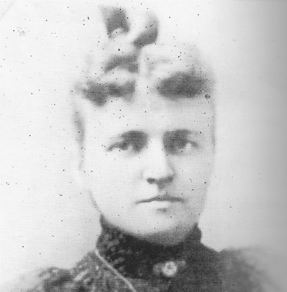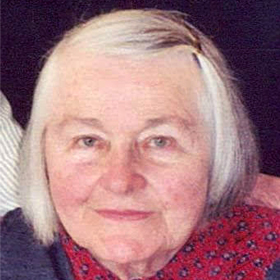When Nora Ouimette (1909-1987) was born in New Bedford, women could not vote! By the time of her death, she had voted in every election she was eligible for, become a labor union organizer, run for Congress and become one of the first female industrial engineers in companies on both the East and West Coasts.
When Nora Ouimette (1909-1987) was born on December 1, 1909 in New Bedford, women had not yet obtained the right to vote! But by her death on October 18, 1987, she voted in every election for which she was eligible, became a labor union organizer, ran for Congress and became one of the first female industrial engineers working in companies on both the East and West Coasts.
Nora was the daughter of Pierre Ouimette, a French Canadian immigrant from Iberville, St. Alexandre, Quebec, and Lenaouette Genereux, a New Bedford native of French Canadian heritage.
As one of six children, Nora needed to leave school and work to help support her family. It was a great personal disappointment for her to not be able to attend high school. Later, she would frequently share this with her own three daughters. Working full-time, however, did not prevent her from completing her high school education through continuing education programs.
According to the 1930 United States census, Nora was a warper tender in cotton mills in New Bedford. She worked at the Wamsutta Mill and then at the National Spun Silk Company from about 1928 through 1931.
A 1931 article in The Standard announced the awarding of a scholarship to Miss Ouimette. The caption under her picture read: “The scholarship for Bryn Mawr summer school for women workers in industry for this section has been awarded Miss Nora Ouimette, 397 Cedar Grove Street. Mrs. Ida S. Ripley, New Center, is chairman of the committee. . . . She [Nora] will leave for Bryn Mawr June 11.” The article indicates “It is the hope of Miss Nora Ouimette, who is going to the Bryn Mawr summer school for two months, that she will be able to bring back helpful information for industrial girls here. Miss Ouimette feels that the girl in industry is faced by many problems and that these problems are becoming more rather than less perplexing.”
Nora was extremely active in the New Bedford YWCA in the 1930s. In 1930, she participated in a debate between the industrial girls of the YWCA and Wheaton college students. The topic was “Why Have Labor Organizations.” The New Bedford women were dressed to represent manufacturers, labor leaders, politicians, mill workers and members of a ladies’ aid society. They debated the negative side, losing to the Wheaton debaters. Nora was also president of the YWCA’s Starlight Club, a group that entertained service men and women. She took an active role in plays presented by the YWCA, including The Lost Sapphire as Mrs. Carey and Who’s Boss? as Mrs. Cheney. Who’s Boss? was presented by the industrial department of the YWCA in Fairhaven Town Hall, with proceeds going to the Julienne Durocher Fund.
Having worked in textile mills and attended the Bryn Mawr College summer program, Nora believed she could make a difference for female workers. The August 14, 1935 Fitchburg Sentinel (Fitchburg, Massachusetts) published an article entitled “Evening Talks to Be Given at Institute Here.” The institute is not named, but the Monday to Saturday evening programs are listed. “Friday evening there will be a labor symposium. The discussion will be upon the subject ‘Labor-After the NRA’.” Thomas Conroy, member of the Worcester Central Labor Union, Nora Ouimette, organizer for the Amalgamated Clothing Workers of America, Leslie Richards, United Textile Workers organizer and John B. McNally, representing the local Central Labor union, will take part in the discussion.” Her active participation in labor unions was also recognized in The Standard-Times on December 1, 1934. An article titled “Labor Organizer Becomes Bride” includes a picture of the bride, groom, best man and bridesmaid. The last paragraph reads “The bride . . . has been active as a labor organizer.”
On her 26th birthday Nora married William Hector Duprey and her life was changed forever. Wishing to do more for the working class, Nora Ouimette Duprey ran as a Socialist for the United States House of Representatives in 1936. She came in last with 0.9% of the vote. Although, to my knowledge, she never spoke of running for Congress, she and my father spoke to the three of us about why they were Socialists. They believed that the Socialist Party was the party which would do the most for the poor, a vital concern in the Great Depression era.
According to the U.S. Census of 1940, she was a homemaker and no longer a member of the workforce. The situation stayed the same with my father working and my mother a homemaker, with just the two of them making up the household until October 4, 1941. That was the day that their first child, Irene Cathy, was born. May 26, 1946 saw the arrival of a second daughter, Diane Vicky and the last of their three children, Rita Madeleine, was born on August 29, 1948. Nora was a stay-at-home mother for a couple of years after Rita was born. It was about that time that my father became ill and my mother was forced to return to work, which probably suited her just fine.
The first job I am aware of my mother having was at Fairhaven Corporation. This was probably in the early 1950s as I have pictures of a Christmas party for the company in 1952. If memory serves me correctly she started out as a stitcher. The owner of the company, Raphael Mutterperl, according to my mother, wanted to train some of the female employees to become time study engineers. She was one of the women chosen. He paid for them to take classes and attend professional seminars, enabling them to become time study engineers at Fairhaven Corporation.
Despite holding a full-time job, she was still responsible for an ill husband and three young children. With only one paycheck coming in, it was necessary for her to stretch every penny as far as she could. With this in mind she taught herself how to knit, crochet, tat and sew. Being frugal by necessity and resourceful, she created her own sewing patterns from newspaper pages. Putting these skills to practical use she knitted sweaters and mittens, crocheted hats, sewed skirts and dresses and created tatted lace-like doilies to provide color and beauty in our home.
Later, in the 1950s or early 1960s, Nora was hired as an industrial engineer at Acushnet Company in New Bedford. She remained at Acushnet Company until the summer of 1963 when she and her daughters moved to California. Her husband had passed away two years prior. Douglas Aircraft in Santa Monica hired her as one of the first female industrial engineers to be employed there. Working in the division which manufactured airplanes, she was required to climb onto the wings and into the interior of the aircraft frequently. Prior to this time, in previous jobs, she always wore skirts and dresses as was expected of women of the day. Climbing onto the planes necessitated wearing pants, something she did for the first time in her life! It took her quite a while to get used to this. I don’t remember her ever wearing pants around the house – she never was comfortable wearing them.
After about three or four years in Santa Monica, Nora and the family moved to the San Fernando Valley. Wanting to lessen her commute, she sought employment closer to home, working at Bunker-Ramo-Woodridge as an industrial engineer, again paving the way for others to follow.
After being forced to retire at age 65, Nora returned to Massachusetts with daughters Irene and Diane and a granddaughter, taking up residence in Lakeville. Although she was retired, she did not sit idly around the house. She joined the Lakeville Historical Society, researching and documenting historical places, people and events in the town. During the country’s bicentennial she became an active member of the town’s Bicentennial Commission, helping to plan and implement many events for the bicentennial year. She spearheaded a production of an old-fashioned melodrama, featuring a heroine in distress, a villain and a handsome hero. She directed this production in which the audience got into the spirit of the play by hissing at the villain, cheering the hero and loving the heroine.
Keeping active was very important to Nora, something she did until she became ill in the 1980s. The life of this pathfinder ended in 1987. She truly lived an active, full life helping to further the advancement of women in a profession traditionally held by men.
Diane Duprey
| In 2020, we asked local students to tell the stories of civically engaged women from the Lighting the Way project through videos—including Nora Ouimette Duprey. |
Information from
-
“Debaters Dress to Illustrate Subject.” The Standard 16 Mar. 1930.
-
“Evening Talks to Be Given at Institute Here.” Fitchburg Sentinel 14 Aug. 1935.
-
“Hopes to Aid Industrial Girls Here.” The Standard 7 June 1931.
-
“In YWCA Musical Comedy.” The Standard-Times 8 Apr. 1934.
-
“Labor Organizer Becomes Bride.” The Standard-Times 1 Dec. 1934.
-
“New Bedford Girls Lose to Wheaton Students.” The Standard 16 Mar. 1930.
-
New Bedford YWCA. Celebrating100Years! 1911-2011. Commemorative ed., 2011, p. 12.
-
“Nora M. Duprey.” The Standard-Times 19 Oct. 1987.
-
Norris, James E., retired Town Treasurer, Lakeville, Massachusetts.
![[Nora Ouimette Duprey], c. 20th century, Photograph, Courtesy of Diane Duprey Photograph of Nora Ouimette Duprey - a woman smiling at the camera, wearing a hat and bundled in sweaters and coats](https://historicwomensouthcoast.org/wp-content/uploads/2018/06/Nora-Ouimette-Duprey-1-543x543.jpg)




